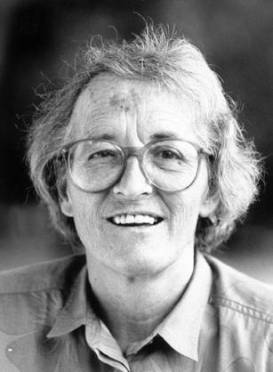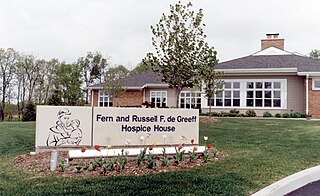Dying is the final stage of life which will eventually lead to death. Diagnosing dying is a complex process of clinical decision-making, and most practice checklists facilitating this diagnosis are based on cancer diagnoses.

Grief is the response to the loss of something deemed important, particularly to the loss of someone or some living thing that has died, to which a bond or affection was formed. Although conventionally focused on the emotional response to loss, grief also has physical, cognitive, behavioral, social, cultural, spiritual and philosophical dimensions. While the terms are often used interchangeably, bereavement refers to the state of loss, while grief is the reaction to that loss.
Palliative care is an interdisciplinary medical caregiving approach aimed at optimizing quality of life and mitigating suffering among people with serious, complex, and often terminal illnesses. Within the published literature, many definitions of palliative care exist. The World Health Organization (WHO) describes palliative care as "an approach that improves the quality of life of patients and their families facing the problems associated with life-threatening illness, through the prevention and relief of suffering by means of early identification and impeccable assessment and treatment of pain, illnesses including other problems whether physical, psychosocial, and spiritual". In the past, palliative care was a disease specific approach, but today the WHO takes a broader patient-centered approach that suggests that the principles of palliative care should be applied as early as possible to any chronic and ultimately fatal illness. This shift was important because if a disease-oriented approach is followed, the needs and preferences of the patient are not fully met and aspects of care, such as pain, quality of life, and social support, as well as spiritual and emotional needs, fail to be addressed. Rather, a patient-centered model prioritizes relief of suffering and tailors care to increase the quality of life for terminally ill patients.

Thanatology is the scientific study of death and the losses brought about as a result. It investigates the mechanisms and forensic aspects of death, such as bodily changes that accompany death and the postmortem period, as well as wider psychological and social aspects related to death. It is primarily an interdisciplinary study offered as a course of study at numerous colleges and universities.
Terminal illness or end-stage disease is a disease that cannot be cured or adequately treated and is expected to result in the death of the patient. This term is more commonly used for progressive diseases such as cancer, dementia or advanced heart disease than for injury. In popular use, it indicates a disease that will progress until death with near absolute certainty, regardless of treatment. A patient who has such an illness may be referred to as a terminal patient, terminally ill or simply as being terminal. There is no standardized life expectancy for a patient to be considered terminal, although it is generally months or less. Life expectancy for terminal patients is a rough estimate given by the physician based on previous data and does not always reflect true longevity. An illness which is lifelong but not fatal is a chronic condition.
According to the model of the five stages of grief, those experiencing grief go through five emotions: denial, anger, bargaining, depression and acceptance. Although it is in common use, studies have not confirmed these stages, and the model has been criticized as outdated as well as unhelpful in explaining the grieving process.

Elisabeth Kübler-Ross was a Swiss-American psychiatrist, a pioneer in near-death studies, and author of the internationally best-selling book, On Death and Dying (1969), where she first discussed her theory of the five stages of grief, also known as the "Kübler-Ross model".

Marie Curie is a registered charitable organisation in the United Kingdom which provides hospice care and support for anyone with an illness they’re likely to die from, and those close to them, and campaigns for better support for dying people. It was established in 1948, the same year as the National Health Service (NHS).

The loss of a pet or an animal to which one has become emotionally bonded oftentimes results in grief which can be comparable with the death of a human loved one, or even greater, depending on the individual. The death can be felt more intensely when the owner has made a decision to end the pet's life through euthanasia. While there is strong evidence that animals can feel such loss for other animals, this article focuses on human feelings, when an animal is lost, dies or otherwise is departed.
Disenfranchised grief is a term coined by Dr. Kenneth J. Doka in 1989. This concept describes the fact that some forms of grief are not acknowledged on a personal or societal level in modern day Euro-centric culture. For example, those around you may not view your loss as a significant loss, and they may think you don’t have the right to grieve. They might not like how you may or may not be expressing your grief, and thus they may feel uncomfortable, or judgmental. This is not a conscious way of thinking for most individuals, as it is deeply engrained in our psyche. This can be extremely isolating, and push you to question the depth of your grief and this loss you’ve experienced. This concept is viewed as a ”type of grief”, but it more so can be viewed as a "side effect" of grief. This also is not only applicable to grief in the case of death, but also the many other forms of grief. There are few support systems, rituals, traditions, or institutions such as bereavement leave available to those experiencing grief and loss.
Therese Schroeder-Sheker is a musician, educator, clinician, and academic dean of the School of Music-Thanatology, which was housed at St. Patrick Hospital in Missoula, Montana from 1992 to 2002.

The Tibetan Book of Living and Dying, written by Sogyal Rinpoche in 1992, is a presentation of the teachings of Tibetan Buddhism based on the Tibetan Book of the Dead or Bardo Thodol. The author wrote, "I have written The Tibetan Book of Living and Dying as the quintessence of the heart-advice of all my masters, to be a new Tibetan Book of the Dead and a Tibetan Book of Life." The book explores: the message of impermanence; evolution, karma and rebirth; the nature of mind and how to train the mind through meditation; how to follow a spiritual path in this day and age; the practice of compassion; how to care for and show love to the dying, and spiritual practices for the moment of death.

Grief counseling is a form of psychotherapy that aims to help people cope with the physical, emotional, social, spiritual, and cognitive responses to loss. These experiences are commonly thought to be brought on by a loved person's death, but may more broadly be understood as shaped by any significant life-altering loss.
Rainbow Hospice and Palliative Care, founded in 1981, is one of the oldest and largest non-profit hospice and palliative care providers in Illinois.

Hospice care is a type of health care that focuses on the palliation of a terminally ill patient's pain and symptoms and attending to their emotional and spiritual needs at the end of life. Hospice care prioritizes comfort and quality of life by reducing pain and suffering. Hospice care provides an alternative to therapies focused on life-prolonging measures that may be arduous, likely to cause more symptoms, or are not aligned with a person's goals.
An online memorial is a virtual space created on the Internet for the purpose of remembering, celebrating, or commemorating those who have died. An online memorial may be a one-page HTML webpage document giving the name of the deceased and a few words of tribute, an extensive information source, or be part of a social media platform where users can add their own words and photos.
David Kessler is an author, public speaker, and death and grieving expert. He has published many books, including two co-written with the psychiatrist Elisabeth Kübler-Ross: Life Lessons: Two Experts on Death and Dying Teach Us About the Mysteries of Life and Living, and On Grief & Grieving: Finding the Meaning of Grief Through the Five Stages of Grief. His first book, The Needs of the Dying, received praise from Mother Teresa and Marianne Williamson.
The following outline is provided as an overview of and a topical guide to death:
Tu Nidito, meaning “your little nest” in Spanish, is a non-profit agency in Tucson, Arizona that provides support for children affected by serious medical conditions and death. The programs they offer include grief support for children and young adults that have experienced the death of a loved one, support for children with serious medical conditions, and support for children and teenagers that have a parent diagnosed with a serious medical condition, such as cancer.
Suicide bereavement is the experience of those who are grieving the loss of someone to suicide. Over 800,000 individuals die by suicide every year. It was stated by Shneidman (1978) that every suicide leaves behind 6 "survivor-victims". However, new research shows that each suicide leaves behind approximately 135 who personally knew the decedent. The #not6 hashtag has been used by Cerel and colleagues to represent that suicide bereavement is many more than publicly portrayed.







